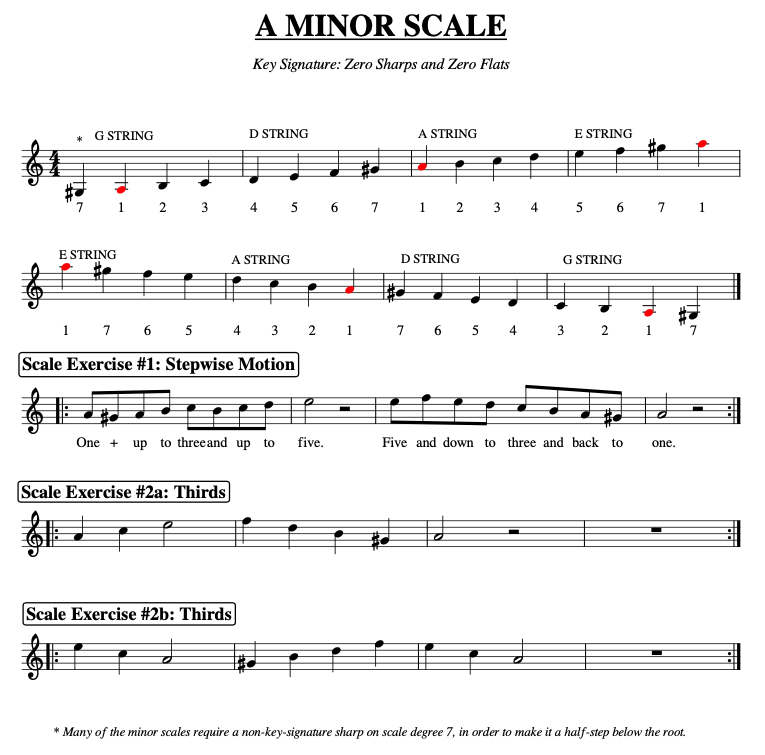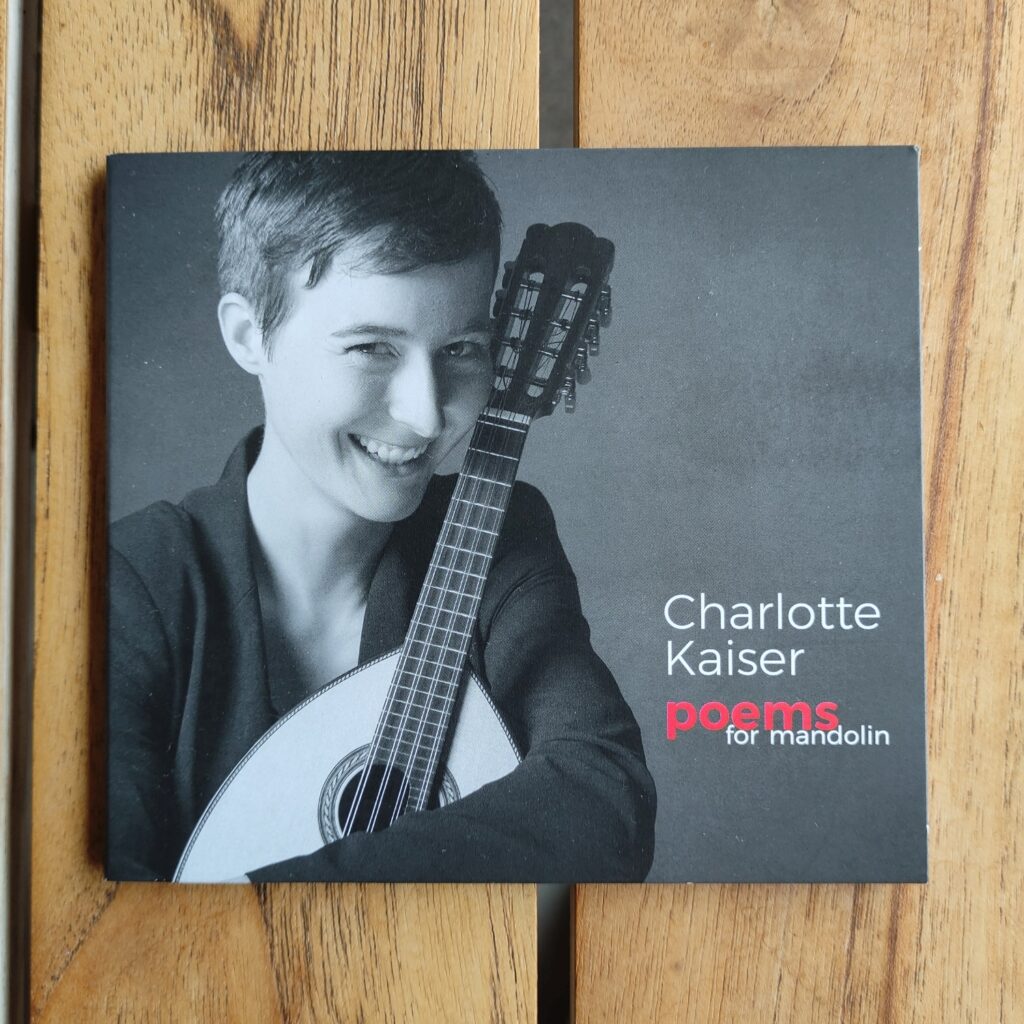In a previous lesson, we noted that the two most common diatonic, seven-note scales are called the major scale and the minor scale. The major scale was discussed in lesson three. This lesson will focus on the minor scale, specifically the natural minor scale.
Relative Majors and Minors
One of the most helpful facts to learn and remember for any musician is the relationship between major scales and natural minor scales. This lesson will very much revolve around the relationship between major scales and their relative minor scales. Does that sound complicated? If so, hopefully this will simplify it a bit: For every major scale, there is a natural minor scale that shares the exact same notes as the major scale. On a mandolin, for instance, the scale of G (G major) is often the first scale a pupil learns. But the G scale has a relative minor, which is E, the sixth note of the G scale. This means that the notes of the Em (E minor) scale are the same exact notes played in the G scale. Simply start on the E note and play the notes of the G scale all the way up to the next E note … that is the Em scale. This works for every major scale and its relative minor. The relative minor is always found at the sixth degree of the major scale. Once the musician understands this, they will realize that learning to play a major scale does double duty: When you learn a major scale, you have automatically learned the relative minor scale. It involves the exact same notes – just start with the sixth degree of the major scale, which now becomes the root of the relative minor scale.
Examples
G major scale in two octaves:
| G | A | B | C | D | E | F# | G | A | B | C | D | E | F# | G |
In the above chart, the notes of the G major scale are given spanning two octaves. The notes shown in red represent the E minor scale. Em is the relative minor of G major, because these scales share the exact same notes. Likewise, G major is the relative major of E minor, because again, these scales share the exact same notes.
E minor scale in two octaves:
| E | F# | G | A | B | C | D | E | F# | G | A | B | C | D | E |
The chart above illustrates that G is the relative major of Em. The notes shown in green represent a G major scale.
Comparing the two charts above will reveal that the sixth degree of a major scale gives the relative minor, in this case Em; conversely, the third degree of a natural minor scale gives its relative major, in this case G.
Although we are using G and Em in these examples, the same relationship holds true of all major scales and their relative minor scales.
Importance of the Third Interval
Notice in the charts above that the third degree of G major consists of a major third interval (4 half-steps or semitones between G and B), while the third degree of E minor consists of a minor third interval (3 half-steps or semitones between E and G).
The third interval in a scale or chord is the basic determiner of the major or minor quality of that scale or chord. Scales built with the minor third interval tend to have that haunting, sort of sad, minor quality. Likewise, chords stacked with a minor third from the root will have a minor quality, while chords stacked with a major third from the root will have a major quality. So when playing music, it is helpful to know where the third interval of a chord or the third note of a scale appears on your instrument. Using a major third produces the major sound in a chord’s structure, and by simply flatting the third (b3) you can change a chord’s quality to the minor sound.
Examples
The C Major Scale with intervals shown:
| 1 | 2 | 3 | 4 | 5 | 6 | 7 | 8v |
| C | D | E | F | G | A | B | C |
| unison | major 2nd | major 3rd | perfect 4th | perfect 5th | major 6th | major 7th | octave |
The A Minor Scale with intervals shown:
| 1 | 2 | 3 | 4 | 5 | 6 | 7 | 8v |
| A | B | C | D | E | F | G | A |
| unison | major 2nd | minor 3rd | perfect 4th | perfect 5th | minor 6th | minor 7th | octave |
In the above charts, we illustrate how the A minor is the relative of the C major scale – same notes. But the order of the notes have changed, because the A note is now the root of the A minor scale. When the order changes, the intervals have to change. There is a half step between the B & C notes, and a half step between the E & F notes. This means that there is no longer a half step between scale degrees 3 & 4 and 7 & 8, so the A scale shown cannot be a major scale. The third degree is now lowered by a half step, making it a minor third, and it is this minor third that gives the scale its minor character. Both the 6th and the 7th degrees are also lowered, due to the half step between E & F (the 5th and 6th degrees). This minor 3rd, 6th & 7th is what constitutes a natural minor scale.
Practical Examples
In order to take a practical rather than theoretical look at how relative majors and minors work, you’ll need to play some notes on your instrument of choice. We will use C major and A minor as our example here.
On the piano keyboard, ALL the white keys represent the notes of the C major and A minor scales. You can play any of the white keys when following the exercise instructions below! The C notes are marked with green dots, and the A notes are marked with red dots.

On the guitar and mandolin fretboards below, ALL the notes of the C major and A minor scale are marked with dots to show all the fingerings for playing the scale notes in first position. The C notes have green dots, and the A notes have red dots. Dots on the “nut” indicate playing the open string there (no fretting).


The markers on the fretboards above indicate all the notes of the C major scale (and therefore all the notes of the A minor scale, because A is the relative minor of C). On the piano keyboard, all white keys belong to C major scale.
The Exercise
1. Key of C: Play a C chord, then play the notes belonging to the scale on your instrument. You can play them in any sequence, even random, just practice playing the correct scale notes above, and try to land fairly often on the C notes (marked in green) — finally ending on a C note, and play a C chord once again. Repeat and do this several times.
2. Key of Am: Play an Am chord, then again play all the same notes in any order, landing often on the A notes marked in red — finally ending on one of the A notes, then play an Am chord again. Repeat several times.
This exercise should help you hear how the same scale, when played with a bit different emphasis and in context, can sound either major or minor. It should help you to learn how a major scale is related to the minor scale built on its 6th scale degree.
A Brief Word About Modes
Have you heard of “modes” in musical scales? Do you know what “modes” are?
Modes are different ways to order the notes of a scale. In this entire course of study, we use the Major Scale as our starting point to learn music theory, so we will approach the idea of modes starting from the major scale. This lesson will not discuss modes in depth, that may come later. A brief discussion is relevant here, because the natural minor scale is a mode … even the major scale is a mode. We will use the scale of C as an example.
When constructing a C major scale, we move from the note “C” up to its octave “C” in the manner described in lesson three, where we define the interval pattern of a major scale. Playing a C major scale from C to its octave is playing the scale in its first mode. That mode is also called the Ionian mode, and it was this mode with its intervals that became what we know as the major scale. If you play all the same notes but make it a different scale, playing the same notes as C major but starting on D and playing up to its octave D, then you are playing the second mode. You can do this by starting on each different note of the C scale, and each time you will be playing a different mode, named 1st through 7th, depending on the scale degree you begin from. Each of the seven modes also have a Greek name. The sixth mode – the Aeolian mode – is what we call the natural minor scale. It is the relative minor of the major scale from which it sprang. There are other minor scales, too. In fact, each of the seven modes will have either a minor quality, a major quality, or a somewhat ambiguous quality. We are concerned with the Aeolian mode in this lesson, the relative minor (natural minor) scale. And it is there that we will leave our mention of modes, and move on to a brief mention of the most common altered minor scales.
Constructing Minor Scales
The natural minor scale can easily be found by considering the sixth degree of the major scale, dealing with relative major and minor scales as we have indicated above. This is a great tool for any musician to have in their tool chest. In addition to relative major and minor scales, we should consider parallel major and minor scales. The parallel relationship would describe the relationship between a major scale (like C major) and its parallel minor (C minor). The way to construct a minor scale from its parallel major (major scale of the same name) would be to flat the third, sixth and seventh scale degrees. We have seen this in the chart and discussion of the minor scale with intervals section above in this lesson. So we have two ways to get to the natural minor scale: (1) From its association with its relative major scale, or (2) by taking the parallel major scale and flatting the third, sixth and seventh degrees.
C Major Scale with its Parallel Minor (C minor)
| Scale Degrees of Major Scale | 1 | 2 | 3 | 4 | 5 | 6 | 7 | 8v |
| Major Scale, C | C | D | E | F | G | A | B | C |
| Difference | 1 | 2 | b3 | 4 | 5 | b6 | b7 | 8v |
| Natural Minor Scale, Cm | C | D | Eb | F | G | Ab | Bb | C |
But there are two other minor scales in common use besides the natural minor scale we’ve been discussing. For useful musical reasons, the natural minor scale is often altered to produce the harmonic minor scale and the melodic minor scale. These alterations are done in order to get pleasing sounds in certain musical contexts, and though (uh-huh) it does complicate things — yes it does — we must give ourselves to understanding this now, or at least take the first step to becoming familiar with it.
The Harmonic Minor Scale
There are harmonic issues with the natural minor scale that have been solved by altering the scale to form what we call the harmonic minor scale. The issues arise because of the seventh scale degree. In the natural minor scale, the seventh scale degree is a whole step below the root. Because of this, there is less “pull” from the root to resolve the seventh note back to the root.
The dominant chord (V chord) of the natural minor scale is a minor chord, becuse of the b3 interval between the 5th and 7th notes of the natural minor scale. To create a major V chord, we can raise the 7th degree of the natural minor scale by a half step. This puts the 7th degree only a half step away from the root, and the pull from the root to resolve that 7th note is much stronger.
For these reasons, the harmonic minor scale was created by raising the 7th degree of the natural minor scale by one semitone, or half-step. Compare below:
Natural Minor Scale, Am
| 1 | 2 | 3 | 4 | 5 | 6 | 7 | 8v |
| A | B | C | D | E | F | G | A |
| unison | major 2nd | minor 3rd | perfect 4th | perfect 5th | minor 6th | minor 7th | octave |
Harmonic Minor Scale, Am
| 1 | 2 | 3 | 4 | 5 | 6 | 7 | 8v |
| A | B | C | D | E | F | G# | A |
| unison | major 2nd | minor 3rd | perfect 4th | perfect 5th | minor 6th | major 7th | octave |
Looking at the charts above: To form the V chord (E) in the key of Am, you stack thirds from the Am natural minor scale to get E-G-B which spells an Em chord. To form the V chord in Am harmonic minor, you get E-G#-B which spells an E major chord.
Altering the minor scale by raising the 7th a half-step solves harmonic problems, so that the dominant V chord becomes major, and the pull from the root to resolve the harmony is strong.
In practice, you play the relative minor scale but raise the 7th degree by a half-step. Or, from the parallel major, you simply flat the third and the sixth, and leave the seventh alone to form the harmonic minor scale.
The harmonic minor scale solved a harmonic problem (chords, harmony, chordal problem) by raising the 7th degree a half-step, but this can create problems from a melody perspective. The problem is that the space between the 6th and 7th degrees was now too big a leap, and it gives the harmonic minor scale a fairly exotic sound. “Exotic sound” isn’t necessarily bad, but also is not always useful. The problem is that the distance between 6 & 7 is three half-steps. The diatonic scales, like major and natural minor, never have more than two half-steps between any of the notes. And so, the melodic minor scale was born to rectify the melodic problem.
The Melodic Minor Scale
There is a property that makes the melodic minor scale a bit unusual: It is most often played with different notes when played ascending than it is when played descending.
The problem with writing melody in the harmonic minor scale is, as has been noted above, there is an extra half step between the 6th & 7th notes. To solve this, we have two solutions that will alter the harmonic minor scale so that there is never more than two half steps between any notes.
The first solution would be to raise the 6th degree by a half step. This will work because there is only a half step between 5 & 6. By raising 6 a half step, we would have a whole step between 5 & 6, a whole step between 6 & 7, and a half step between 7 & 8 for harmonic resolution to the root. No two notes of the scale would have more than a whole step between them.
The second solution would be to simply lower the 7th by a half step. Note that this simply reverts the harmonic minor scale back to the natural minor scale.
The melodic minor scale was created by using both solutions. When ascending the scale, both the raised 6th and the raised 7th are played, and when descending the scale, the natural minor scale is played naturally.
Play Your Instrument: Hear The Differences
Reading all this theory can be helpful, but only if you internalize the information. Put your hands on your instrument. Pick a major scale that you are comfortable with, and play it a few times. Now find the sixth degree of that scale, and play the same notes, in order to play the relative minor scale. It helps if you play the minor chord to begin and end.
Once you are used to playing the natural minor scale (relative minor), then start playing it again but raise the 7th note a half step. Play it ascending and descending, and listen to the exotic interval between 6 & 7.
Now, practice playing the scale again, this time raising the 6th as well when you ascend the scale, followed by playing the natural minor scale going down. Once you can accomplish this, you have played the melodic minor scale.
RE-CAP
1. Every major scale has a relative minor scale that shares the same exact notes, starting on the 6th degree of the major scale.
2. By-and-large, the 3rd interval defines the sound of major and minor.
3. The natural minor scale is parallel to its major scale of the same name, but with a b3, b6 & b7 degree as compared to its major scale.
4. The harmonic minor scale raises the 7th degree of the natural minor scale.
5. The melodic minor scale raises the 6th degree of the harmonic minor scale when played ascending, but uses the notes of the natural minor scale when descending.
Homework
1. Written work:
- Write out the notes of at least three major scales of your choosing.
- Write out the relative minor scale for each of them.
- Write out the harmonic minor scale versions.
- Write out the ascending melodic scale versions.
2. On your Instrument, play the scales you wrote out.
3. Read through this entire lesson at least one more time, and try to find how to play examples of each concept on your instrument.
4. DISCOVER: You will note that the ascending form of the melodic minor scale is the same notes as the parallel major scale with only the 3rd flatted. It is basically the 3rd interval that defines major vs. minor quality!
————————————-
If you find it difficult to understand any of the concepts in this lesson, take time to re-read the lesson with your instrument of choice at hand, and play the notes discussed in this lesson. Listen to the sounds, and think about how they relate to what is being taught here. You can make suggestions or ask questions by shooting me an email, I’ll do my best to answer.






























